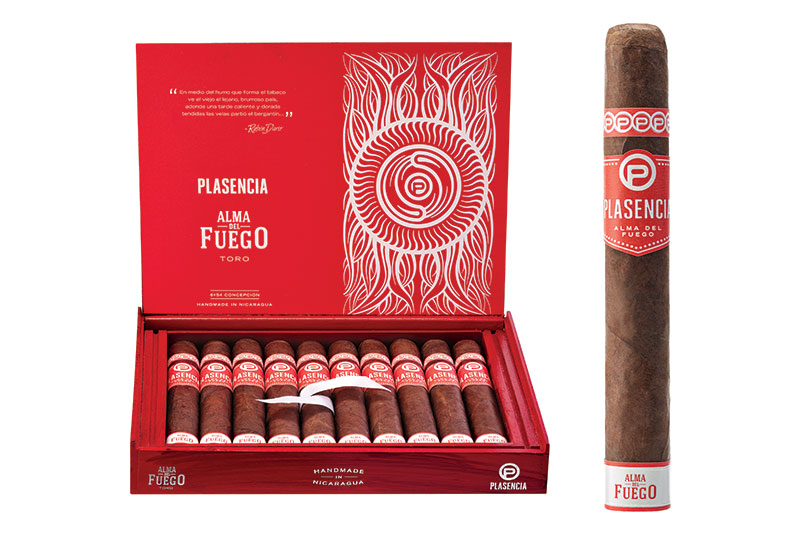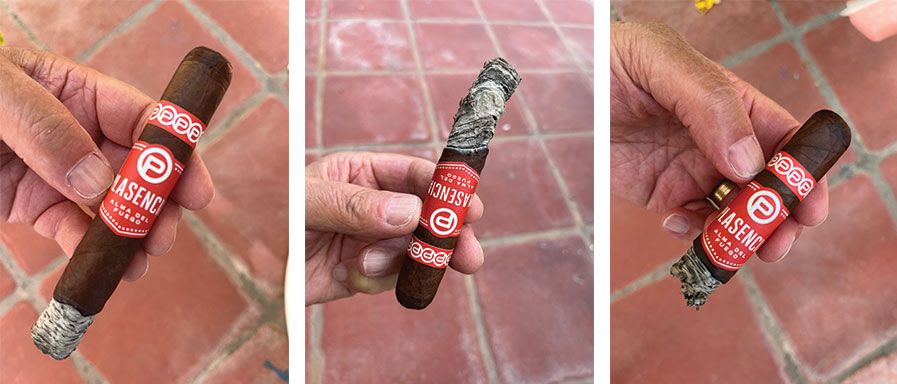Reviewing a cigar dubbed The Soul of Fire can be a bit daunting. The implication is that it is going to be a powerhouse of a smoke, leaving the palate ablaze and begging for relief! Thankfully this was not the case with Plasencia’s third offering from their high-scoring Alma series of all-Nicaraguan puros. Rather, the Alma del Fuego was, and is, a well-balanced and full-bodied cigar, offering both sweet and savory notes in one harmonious package.
The word Fuego refers to the source of the majority of the cigar’s leaf, the Nicaraguan island of Ometepe, home to two volcanoes, one of which is still active. The “fire” of volcanic eruption has created an especially fertile soil in which to plant cigar tobacco. The unique qualities of the Ometepe leaf will be discussed in this review.
It is likely no coincidence that the color scheme for this fiery product is principally red. The cigar box, the primary band, and the narrow ring above it, are predominantly red. The white foot band is also trimmed in red. Not surprisingly, the Alma del Fuego Candente itself presents a ruddy, reddish-brown wrapper leaf, although that leaf is from the Jalapa growing district, not the Ometepe region. All of the tobaccos for this cigar were grown exclusively on the Plasencia family’s own farms.
Appearance: The Candente is a visual stunner. The soft box pressing gives the classic 5 x 50 robusto a pleasingly contoured shape, and just the right amount of firmness and forgiveness. The wrapper is a beautiful shade of chestnut, with some darker streaks highlighting the copper-colored leaf. Overall this wrapper is a darker shade than I usually expect from Jalapa-grown leaf, so, warning sign duly noted! The cigar’s texture has a nice sheen without an over abundance of oils. The head is triple-capped, and the foot is enclosed by the wrapper, which covers all but the very center. A few minor veins are visible while the seams are barely noticeable. This stogie practically screams “smoke me!”
Pre-light aroma: The Jalapa wrapper exudes a pungent sweetness, with a deep earthiness, and hints of dried fruit coming from the foot.
Cold draw: A standard ¼” punch cut opens up a good, slightly firm draw, with just enough resistance. The stone fruit sweetness has an earthy component to it, mimicking the aromas from the foot. At this point there’s no hint of spiciness.
Initial light-up: A single-flame torch sharply toasts the foot, burning off the enfolding wrapper, and opening the draw. Flavors of subtly sweet fruit are punctuated by a nice amount of peppery spice, which tickles the upper palate and nasal passages. This promises to be the anticipated Nicaraguan combo of sweet and spicy.
The ensuing char line is sharp but begins to waver, rising and falling like a stock market graph. It’s not affecting how the cigar smokes at this point, so long as it doesn’t “canoe.” The ash begins to build as a steel-gray stack, at once dense yet flaky. It holds on well though, only dropping off after a firm tap when it reaches the 1 ½” mark. The char line continues to meander, but so far not to the point of needing a touch-up.
First third: The Candente starts out with nearly equal shares of peppery spice and fruity sweetness. There’s also a hint of citrus tang somewhere in there, along with the stone fruit. The pepper tingles the nose and tongue and really shows up on the retrohale, but never so much that it takes away from the other flavors. The strength and body are at medium, progressing toward medium-full.
Second third: As the second solid ash drops off it leaves a cone of filler protruding from the foot. Either the filler is damper than wrapper and binder, or the Ometepe leaf is simply a slower burn than the rest of the tobaccos. We’ll keep an eye out for any changes in combustion. The flavor profile is morphing somewhat. The spice is receding, the stone fruit sweetness is toning down, and the anticipated nuances of coffee, cocoa and wood are picking up. This seems like a point of transition for the Alma del Fuego, with the strength leveling off and the complexity ramping up. That’s a good sign.
Last third: The body is slowly increasing, accompanied by a newer, as yet unexperienced taste sensation. The tendency is to describe it as a mineral-like flavor, but it’s not quite that, and there isn’t the negative aspect I associate with a mineral characteristic. The only explanation I can come up with is that I’m finally recognizing the qualities of the Ometepe tobacco. Surely all that volcanic soil would lend an earthy, mineral-like aspect to the flavor profile, and that’s what I’m experiencing. The former sweet sensation of fruit is minimal, just enough to be noticed, but the pepper spice has become more robust after a brief absence. Approaching the nub is bringing with it an almost light-headed sensation, so the strength has hung in there. It should be noted that the combustion has improved markedly, with a relatively straight burn line and a flat, even ash. The former cone of filler disappeared with the last ash drop, all 2” of it, leaving a nice straight ash at the foot. The final nub is intact and has not heated up, but I’m feeling a bit woozy so I reluctantly let it go out on its own.
Summation: I was fortunate to have several samples for this review. They mostly provided remarkably similar smoking experiences, with a few notable exceptions:
One sample started and finished at no more than medium strength and body. All the other samples built up to full in both categories.
Almost every sample began with a bit of resistance to the draw, which eventually eased up. One sample was free drawing from start to finish, and consequently became softer and finished sooner than the others.
The last two samples I smoked presented more of what I came to interpret as the properties of Ometepe tobacco: stronger, earthier, more mineral-like.
This is not to imply a lack of consistency in these cigars, but rather it showcases the predictable variation from a natural product, no matter how man may try to manipulate the outcome.
What every sample had in common was an alluring appearance, solid construction and a deeply satisfying smoking experience. There was enough transition to regard the Candente as complex, and yet it delivered an even flow of flavor, aroma and body, not to mention an ample supply of oomph.
I would gladly add these to my rotation and would recommend Alma del Fuego to any seasoned cigar aficionado, without hesitation. Thumbs up!

Plasencia Alma Del Fuego
- Size: Candente (5 x 50)
- Country of Origin: (Nicaragua)
- Wrapper: Nicaragua (Jalapa)
- Binder: Nicaragua
- Filler: Nicaragua
- MSRP: $16.52
- Smoking Time: 1 hour, 10 minutes
- Release Date: July 2019
– Samples courtesy of Plasencia Cigars. Review by Larry Wagner.

